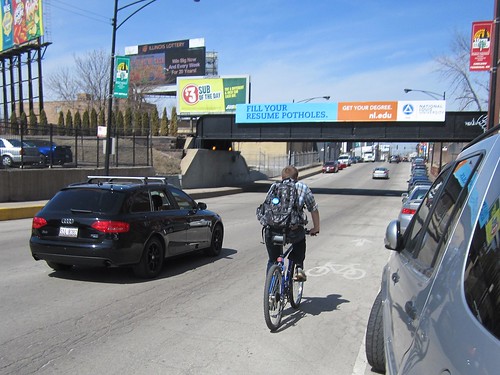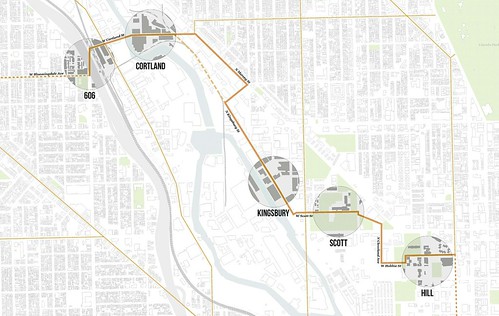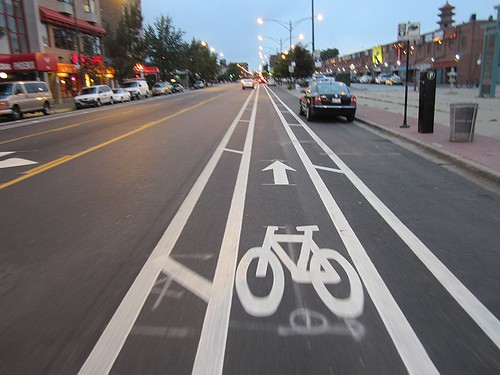It's good to see that new Chicago Department of Transportation Commissioner Rebekah Scheinfeld is standing her ground on the Elston bike lane issue.
In December, when CDOT staffers discussed plans for buffered bike lanes on Elston between North and Webster at a meeting hosted by the North Branch Works industrial council, there was stiff resistance from local business owners. Although there’s currently a protected lane on the street from Division to North, and a faded conventional lane on most of this stretch, they argued that encouraging more cycling on the street would interfere with truck movement and endanger bike riders. When I spoke to Mike Holzer, director of economic development for the North Branch Works, he said cyclists should be encouraged to take Milwaukee instead, although there have recently been many dooring crashes on that street.
In January, as an alternative to upgrading the Elston lanes, the industrial council lobbied CDOT to build a bicycle route proposal designed by a local architecture firm, dubbed “A New Bike Route.” This roundabout itinerary would connect the east end of the Bloomingdale Trail with buffered lanes on Wells, but it would also add half a mile to a trip downtown, plus numerous additional turns and three unsignalized crossings of major streets. While the route has merits, it’s not a practical alternative to simple, direct Elston.
Scheinfeld said all the right things in a March 21 memo to Holzer, also sent to local aldermen Robert Fioretti (2nd) and Scott Waguespack (35th), which explained why CDOT wants to move forward with the buffered lanes. She pointed out that bikes sometimes make up 11 percent of all traffic on Elston during rush hours. “This high level of ridership indicates that many people find Elston Avenue to be a convenient route between their origin and their destination,” she wrote. However, while 5.2 percent of the reported traffic crashes on Elston involved cyclists, 26 percent of the crashes resulting in injuries did, so it’s clear that bike safety needs to be improved on the street.
Scheinfeld went on the acknowledge the concerns about safety, congestion, parking supply, lane widths, truck turning movements at intersections, and loading dock access. She then explained how buffered lanes will have virtually no negative effect on trucking operations, but will make bike crashes less likely. “Adding buffers on both side of the existing bike lanes would increase the lateral separation between bikes and motor vehicles (including trucks), and between bikes and parked cars, thus improving safety.”
The buffered lanes will not displace any on-street parking spaces between North and Cortland, although parking will be removed on the one block stretch between Cortland and Ashland. One concession CDOT is making to the business owners is widening the mixed-traffic lanes to 11 feet – the design proposed in December had 10.5-foot lanes.
Cortland/Ashland to Daley Plaza | Elston Ave. | "A New Bike Route" |
Distance | 3.5 mi. | 4 mi. |
Turns | 4 | 11 |
Unsignalized crossings | 0 | 3 |
Cost | $200-250,000 | $1,000,000-$25,000,000 |
She went on to address the “A New Bike Route” proposal, which features protected bike lanes and off-street paths along side streets and parks. In addition to being longer and less convenient for cyclists, this network would cost $1-2 million to build, compared to $200-250,000 for the Elston buffered lanes, she said. If extensive street reconstruction was involved, as shown in the ANBR proposal, it could cost $20-25 million. She said CDOT may consider building some version of the route in the future. However, said the proposal “does not serve as a suitable alternative to Elston Avenue.”
Likewise, Scheinfeld pointed out that Milwaukee is no substitute for Elston because it has no bike lanes north of Division, and building them would require removing parking or a travel lane. “This might be an option in the future,” she said.
CDOT project manager Mike Amsden presented an update on the plan for buffered lanes at a North Branch Works meeting last Thursday. Judging from a short writeup in the industrial council’s e-newsletter, it appear that they’re on board with the current plan, if perhaps a bit unclear on the concept. The writeup says the plan “will re-install the traditional striped bike lanes that existed before,” which suggests that the author wasn’t aware of the difference between conventional and buffered lanes.
In effect, not much has changed from CDOT’s original proposal for buffered lanes. However, the department seems to have succeeded in convincing the business owners that adding a couple extra stripes of thermoplastic to the original Elston bike lane design won’t cause a disaster for their trucking operations. The lanes are slated for construction in late 2014 or early 2015.
Yesterday, members of the advocacy groups Bike Walk Logan Square and Bike Walk Lincoln Park sent an open letter to the aldermen supporting CDOT’s plan. Although the members would have liked to have seen the existing protected bike lanes extended north of North, they say buffered lanes are the next best thing. “We consider this a generous compromise — one that would improve safety for cyclists and minimally affect the movement of trucks through the [corridor],” they wrote. “Anything less than buffered bike lanes on Elston would be in obstinate defiance of the city’s Complete Streets guidelines, which ensure ‘that our streets are safe and designed for all users.’”







